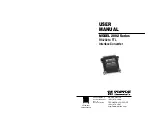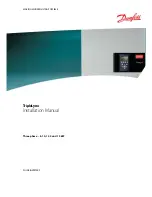
11
Only connect the inverter’s DC input to existing wiring (which must be approved for
marine use) at the appropriate gauge, cable and length (see the “Specifications”
section, page 16). For cable lengths exceeding 6 feet from inverter to batteries, call
Vector for additional installation information. The cable, fuse holder and fuse (not
supplied) can be purchased at an electrical supply company. The fuse holder and fuse
are a specified amperage rating (see Specifications, page 16). Call Vector Technical
Support at (954) 584-4446 or toll-free at (866) 584-5504 with any questions.
Inverters must be securely fastened to bulkheads, floors, ceilings or other vessel
structural parts. They should be mounted horizontally so the fan area is not blocked.
When mounted, the base of the inverter must be at least two feet above normal bilge
water, and protected so it is not subject to bilge splash.
Inverters are NOT IGNITION-PROTECTED and should NEVER be installed in engine
rooms of gasoline-powered boats.
Installation Procedures
When wiring the inverter to a 12 volt DC power source, ensure that polarity is correct.
Reversed polarity will blow a fuse and may cause permanent damage to the inverter.
Review diagrams on page 2, if necessary, to identify the location of the DC terminals.
Note:
The manufacturer’s warranty does NOT cover damage due to reversed polarity.
Quick Operational Test or Emergency Use
You will need:
• A heavy-duty jumper cable set of the specified AWG wire rating (see the
“Specifications” section, page 16)
• A fully-charged automobile battery
• A common slip joint plier for loosening and tightening terminal nuts
PROCEDURE
1. Unscrew nuts in input terminal block.
2. Identify the POSITIVE and NEGATIVE terminals on the 12 volt DC battery (or
other 12 volt DC power source) and identify the POSITIVE and NEGATIVE
terminals on the inverter.
3. Using a set of heavy-duty jumper cables, attach the red cable to the inverter’s
POSITIVE (+) terminal and the black cable to the inverter’s NEGATIVE (–)
terminal.
4. Connect the clamps on the other ends of the jumper cables to the corresponding
POSITIVE (+) and NEGATIVE (–) terminals on the 12 volt DC vehicle battery (or
other 12 volt DC power source). There may be some minor sparking.
5. Turn the inverter ON/OFF Switch ON.
6. Plug in a lamp with a 100 watt light bulb and switch the lamp on. If the lamp
works normally, the inverter is functioning properly and you can proceed to
a permanent installation or continue to use the inverter with low wattage
appliances. If the lamp does not light or does not work correctly:
A. Check all connections and tighten any that may be loose.
B. Ensure that the source battery has adequate charge.
C. If steps A and B do not correct the problem, contact Vector Technical Support,
toll-free, at (866) 584-5504, for assistance.
10
INSTALLATION
MAXX SST
™
Portside Power Inverters will provide you with continuous electrical power
when powered by a 12 volt DC source, such as a vehicle battery or a multiple battery
configuration (see the diagram under “Battery Configuration,” page 8). This manual
does not describe all of the possible configurations.
Operating Environment
Do not locate inverters in an area, room or compartment where explosives or
flammable fumes might be present, such as engine rooms, engine compartments, and
boats or small, unvented battery compartments.
To avoid possible dangerous conditions, the inverters must be located where:
1. The unit is well-ventilated and dry, away from heat sources, such as dry engine
exhaust and other heat-producing devices;
2. Air temperature is between 30°F (–1°C), non-condensing, and 105° F (40°C);
3. At least three inches of clearance from other objects is maintained for cooling
airflow;
4. The unit is not exposed to direct heat, sunlight or to explosive or flammable fumes;
5. The unit is as close to the DC power source as possible;
6. The unit is located so that hinged covers, access plates and all inverter controls
(switches, outlets and indicators) are readily accessible;
7. The unit is NOT installed directly over batteries — explosive gasses can ignite
and corrosive fumes can damage inverter components;
8. The unit is protected from falling objects, spray or dripping fluids;
9. Overcurrent protection is installed in the DC input circuit — this can be either
fuses or circuit breakers.
10. A means of achieving strain relief is installed within six inches (6") of the inverter
enclosure.
Never connect the chassis ground wire from the inverter to the DC NEGATIVE input.
• CHECK to ensure that the combined loads of the appliances being powered by the
inverter DO NOT continuously exceed the inverter’s wattage rating.
• NEVER place items on or over the inverter during operation
Inverters generate heat during operation and must be placed where cool air can
circulate to the internal fan, and hot air can be removed.
For optimum operation, the inverter should be placed or mounted on a flat
surface; ideally, a normally cool metal surface to help diffuse the heat that is generated.
Two cables (see the diagram on page 8) are not supplied, but will be required to allow
for full power operation and to provide flexibility in positioning the inverter.
Marine Applications
In addition to the above recommendations and all cautions and warnings listed in the
Important Safety Instructions at the beginning of this User’s Manual, observe the
following in all marine applications:
DO NOT install the inverter below or near the waterline, and keep the inverter away
from moisture and water.
Use ONLY non-corrosive marine fasteners and fittings for installation.
VEC049_50_51GM_Manual_041906 4/20/06 4:09 PM Page 10




























